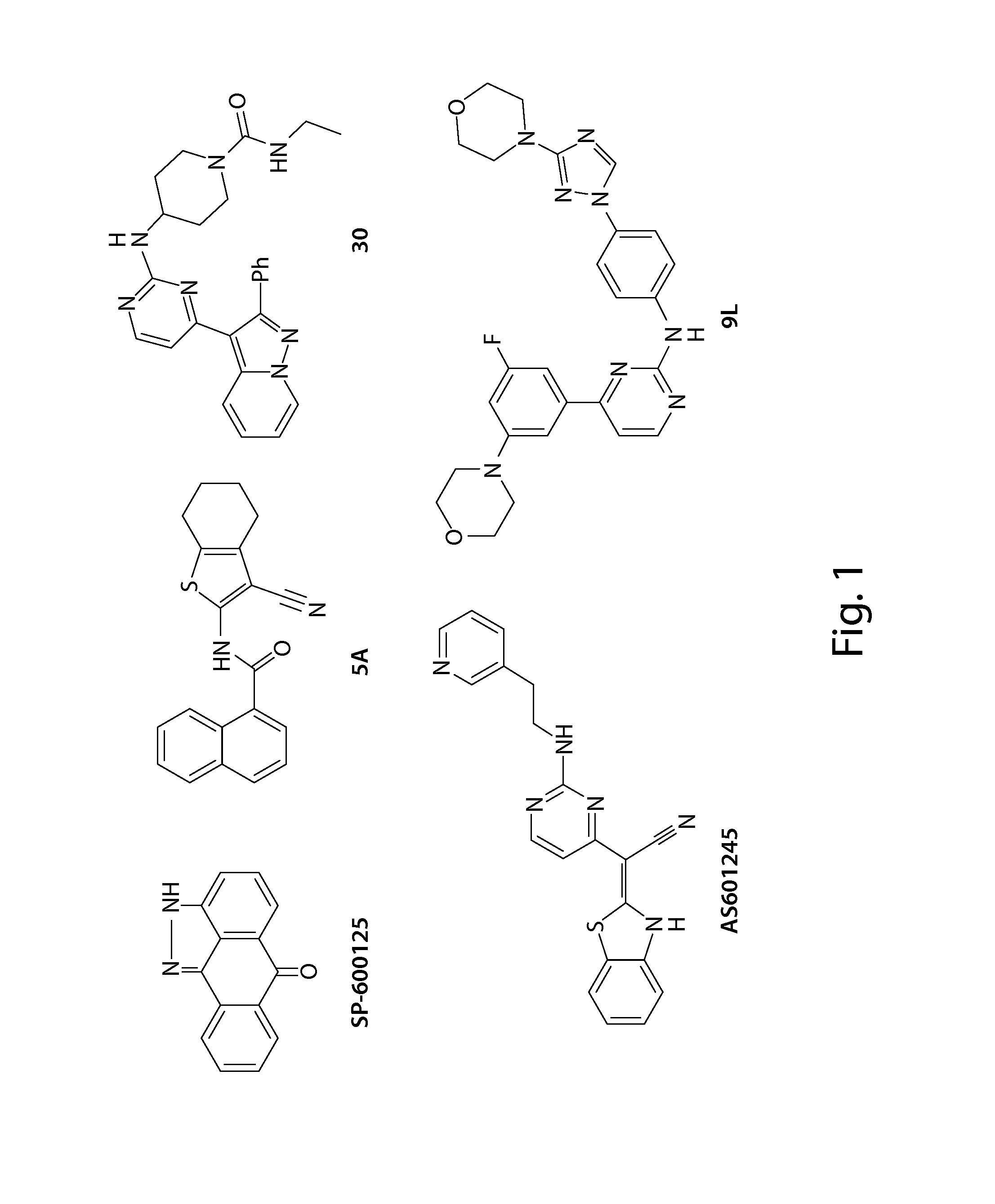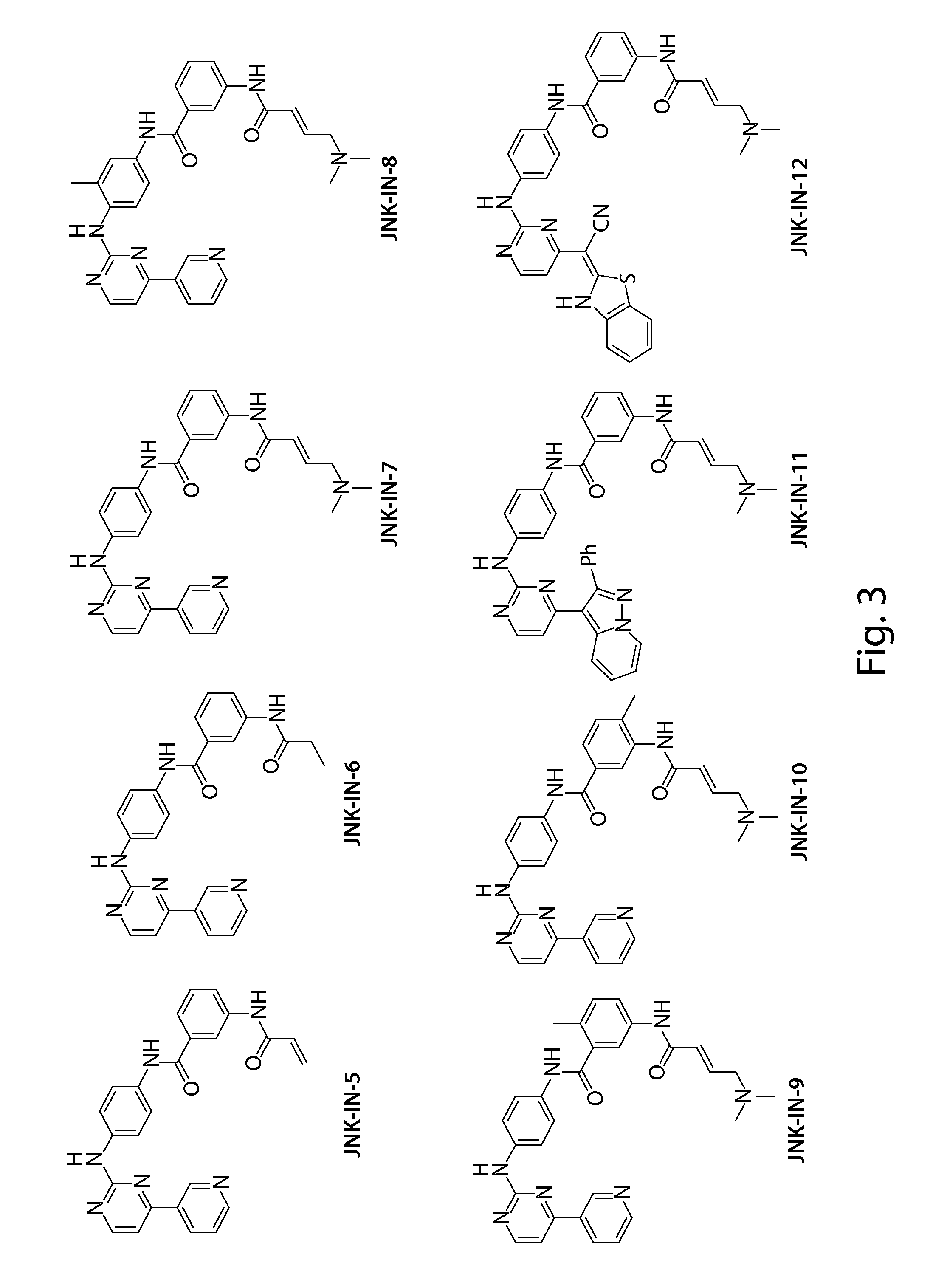Inhibitors of c-jun-n-terminal kinase (JNK)
a kinase and inhibitor technology, applied in the field of mapk (mitogen-activated protein kinase) signaling system, can solve the problems of not being able to inhibit the phosphorylation of well-characterized substrates of jnk in cells, no direct jnk inhibitors have been approved for human use, and many poor kinase selectivity, etc., to reduce tumor burden, delay or minimize one or more symptoms, and stop the growth or spread
- Summary
- Abstract
- Description
- Claims
- Application Information
AI Technical Summary
Benefits of technology
Problems solved by technology
Method used
Image
Examples
example 1
Preparation of the Compounds
General Synthetic Methods
[0368]The compounds provided herein can be prepared from readily available starting materials using the following general methods and procedures. See, e.g., Scheme 1 below. It will be appreciated that where typical or preferred process conditions (i.e., reaction temperatures, times, mole ratios of reactants, solvents, pressures, etc.) are given, other process conditions can also be used unless otherwise stated. Optimum reaction conditions may vary with the particular reactants or solvent used, but such conditions can be determined by those skilled in the art by routine optimization procedures.
[0369]Additionally, as will be apparent to those skilled in the art, conventional protecting groups may be necessary to prevent certain functional groups from undergoing undesired reactions. The choice of a suitable protecting group for a particular functional group as well as suitable conditions for protection and deprotection are well known...
example 2
Assays of the Compounds
Intact Protein Analysis
[0387]For each analysis, about 100 pmol JNK protein + / − inhibitor (JNK-IN-7) was injected onto a self-packed reversed phase column (1 / 32″ O.D.×500 μm I.D., 5 cm of POROS 10R2 resin). After desalting, protein was eluted with an HPLC gradient (0-100% B in 4 minutes, A=0.2 M acetic acid in water, B=0.2 M acetic acid in acetonitrile, and flow rate=10 μL / min) into a QTRAP mass spectrometer (AB Sciex, Toronto, Canada) or an LTQ Orbitrap mass spectrometer (ThermoFisher Scientific, San Jose, Calif.). The QTRAP was operated in Q1 MS mode at unit resolution scanning at 2000 amu / sec. LTQ OrbitrapMS spectra were acquired in centroid mode using the electron multipliers for ion detection. Mass spectra were deconvoluted using MagTran 1.03b2 software.
Protease Digestion and nanoLC / MS Analysis of Peptide Fragments
[0388]JNK-IN-7 treated JNK (25 μg, about 620 pmol) was diluted with ammonium bicarbonate buffer at pH 8.0 and then reduced for 30 min at 56° C. ...
PUM
| Property | Measurement | Unit |
|---|---|---|
| Pharmaceutically acceptable | aaaaa | aaaaa |
Abstract
Description
Claims
Application Information
 Login to View More
Login to View More - R&D
- Intellectual Property
- Life Sciences
- Materials
- Tech Scout
- Unparalleled Data Quality
- Higher Quality Content
- 60% Fewer Hallucinations
Browse by: Latest US Patents, China's latest patents, Technical Efficacy Thesaurus, Application Domain, Technology Topic, Popular Technical Reports.
© 2025 PatSnap. All rights reserved.Legal|Privacy policy|Modern Slavery Act Transparency Statement|Sitemap|About US| Contact US: help@patsnap.com



